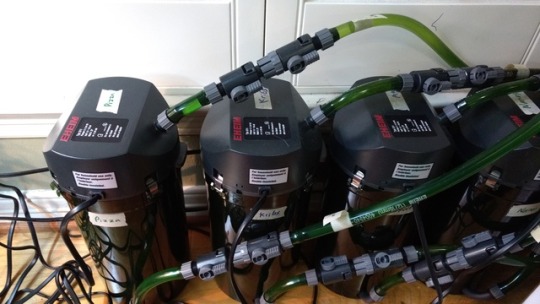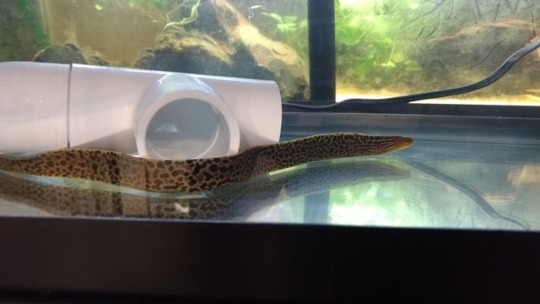#Gymnothorax polyuranodon
Explore tagged Tumblr posts
Text
A true freshwater moray
Tiger or manytoothed moray eels, "Gymnothorax" polyuranodon, are so far the only moray eel species verified to habitually inhabit freshwater environments as adults. Of course their entire life cycle includes a spell in the ocean, which appears to be necessary to anguilliforms, but this is currently the only moray species known to spend its adult life in freshwater.
Adult eels of this species inhabit almost solely coastal freshwaters, both still and moving, so it is considered to be a true freshwater moray, and not an estuarine form that visits upstream. Although it inhabits estuaries also, it is about twice as common in pure freshwater, and avoids strongit brackish salinities. Technically, their life cycle is catadromous, meaning they begin life out at sea, before migrating upstream with age.
Despite the fearsome reputations of morays, the tiger moray has evolved as a specialized, probing forager of small prey, which are probably arthropods. As a consequence, they are safe sharing an aquarium with surprisingly small fishes, because their teeth are small, relative to their own jaws, and their heads have similarly become small relative to their overall length.
The aquarium pH ought to be 7 to 8, and their diet should be meaty morsels, provided in suitably cut sizes. Because these eels are found far upstream in natural environments, the addition of aquarium salt is entirely unecessary, although the low end of brackish salinities, such as 1.005, should not harm these eels, either. As adults, they do not dwell in the sea, so they should never be regarded as marine fishes.
However other details of their biology and care, do match those of the better known marine.morays, such as their nocturnality, and their need to frequent hiding places by day. Temperatures should be 24 to 28 degrees, and they are certainly flourishing in aquariums, cared for as I have described above.
#Gymnothorax polyuranodon#tiger moray#freshwater moray eel#oddballs#predator fish#aquarium eels#manytoothed moray
0 notes
Photo


One might rightly wonder why the newest eheim in the lineup is simply labeled "Pizza". Wonder no more.
99 notes
·
View notes
Text


My OC from Arknights. She is an abbysal hunter codenamed Destreza. She is inspired in the tiger moray eel (Gymnothorax polyuranodon).
22 notes
·
View notes
Note
What do you know about bluestripe pipefish (doryrhamphus excisus) and and the dwarf golden moray (gymnothorax melatremus) (I think those are the correct scientific names?) in terms of brackish tolerance?
From firsthand experience? Next to nothing - most of my knowledge is on the commercially available species (brackish or otherwise) and North American Native fish. But! I do have a few resources for looking into these sorts of things.
The Bluestripe Pipefish seems to be most heavily associated with reefs; but marine pipefish in general do best between 1.021 and 1.025 specific gravity which is technically “brackish” but nobody really considers it as such. Looking for a brackish pipefish? Try Microphis brachyurus (link) or Enneacampus ansorgii (link). But in general, keep pipefishes in a species-only tank for the most realistic chance for success.
Likewise, the Dwarf Golden Moray is reef-associated, so I wouldn’t keep below 1.022 or 1.023 - 1.025 to 1.026 is better. Better brackish morays include Echidna rhodochilus (link), Gymnothorax tile (link), and Gymnothorax polyuranodon (link). Of these, E. rhodochilus is the best for community tanks - the others are best kept alone or in species-only tanks.
1 note
·
View note
Text
i uhhhh stopped at this absolutely heavenly fish store outside of columbus called rivers to reefs and talked to the guys in there for like an hour. they actually knew what i was talking about when i mentioned gymnothorax polyuranodon, anguilla dieffenbachii, and betta persephone, holy shit.
came out with a promise to meet up at catcon, dibs on the next g. polyuranodon/tile shipment, and 3 mochokiella paynei👌

#those are $23 each but worth it#expensive babies#fish tag#they also had glass eels but the shipper didn't label them#and i'm kicking myself for not buying one now#coulda had a longfin......
51 notes
·
View notes
Text
'Freshwater' moray eels for the brackish tank
As a child I was surprised and fascinated, to meet in aquarium retailers, something I did not know existed - a freshwater moray eel. In fact confusion and misinformation surrounds the matter of freshwater and brackish morays in the aquarium trade. Fortunately the species traded, was and is almost always a well known species, specifically "Gymnothorax" tile, the Indian mud moray of ichthyologists. (Gymnothorax is currently quite an unnatural grouping of muraenid, or moray eel species, as is Echidna.)
This trade labelling is unfortunate, because these eels merely visit freshwaters, and do not seem to flourish upriver, in the long term. Whereas they do well tolerate life in the low salinities of estuaries, similar to scats, monos, and the like. Fortunately the mud moray is an easy fish to care for, if only its basic requirements are met by a conscientious aquarist. Moray eels as a whole are robust aquarium denizens.
In the wild, this 60 centimeter or 24 inch long eel, inhabits the muddy river estuaries entering the Indo-West Pacific oceans. Though it may also be found in inshore seas, this eel is considered primarily a brackish water animal. In the aquarium, it unsurprisingly does fine at a salinity from 1.010 up to marine salinity, and at a temperature of 22 to 30 degrees centigrade.
These are a clumsy, predatory fish, and quite inoffensive to any tankmates too large to be recognised as prey by the eel, including similarly sized conspecifics. So a number of mud morays can safely be accommodated together, and with other fish sharing their environmental requirements.
The aquarium lighting should be dim, or if not, the eel should have access to a shaded portion of the aquarium. Decor should also facilitate such hiding behaviors, on the basis that the nature of all morays is to lurk. Feeding this carnivore is unproblematic, using items from the fishmongers, or defrosted meaty foods.
Two other morays are sometimes traded as freshwater species, but only one of them, the tiger moray ("Gymnothorax" polyuranodon) actually is. The pink lipped moray ("Echidna" rhodochilus) is a more durophagous species, consuming hard shelled prey items most moray species cannot crack open, though but contents from "Echidna" eels prove them to consume small fishes as well. This is a smaller eel than the mud moray, that grows to nearly 35 centimeters, or 14 inches in length.
The pink-lipped or white-checked moray, like the Indian mud moray, is another Indo -Pacific species found wild in brackish conditions, as well as in adjacent coastal seas, and it seems, only as a vagrant when it is encountered further upriver. For this species, parameters as suggested for the Indian mud moray should suffice, and the two species are in fact compatible tankmates. Of these two estuarine species, the pink-lipped has a reputation as bolder, but its more rarely encountered in aquariums.
At least two further moray species are recorded from estuaries, but they are not to my knowledge traded under the label of "freshwater moray eel" - the yellow spotted or "skeletor" moray ("Echidna" xanthospilos), although it is sometimes traded in the saltwater hobby, and the Gangetic moray (Strophidon sathete), which also happens to be the longest described moray species.
Despite certain species living part of their life cycle in freshwaters or estuaries, anguilliforms or true eels and their allies seem constrained to spend part of their life cycle at sea, as planktonic leptocephali, during which time they consume marine snow. Even the freshwater tiger moray, has a marine stage in its life cycle.
#freshwater moray eel#Brackish fishes#misunderstood fish#Gymnothorax tile#Indian mud moray#Pink-lipped moray#Echidna rhodochilus#aquarium eels#White-cheeked moray#oddballs
0 notes
Text
i finally found a trio of my unobtainable dream eels for the (comparatively) low price of $565 but i don't have the space for three 5 foot eels right now, so frankly, life can suck it,,,,
#gymnothorax polyuranodon#the rotten bananas#the dreamy men#who are way too big for anything i have right now#we're talking... 2k+ gallons probably#today has not been great#fish tag#these usually retail at $200+ and finding them is a once-in-a-lifetime thing
36 notes
·
View notes